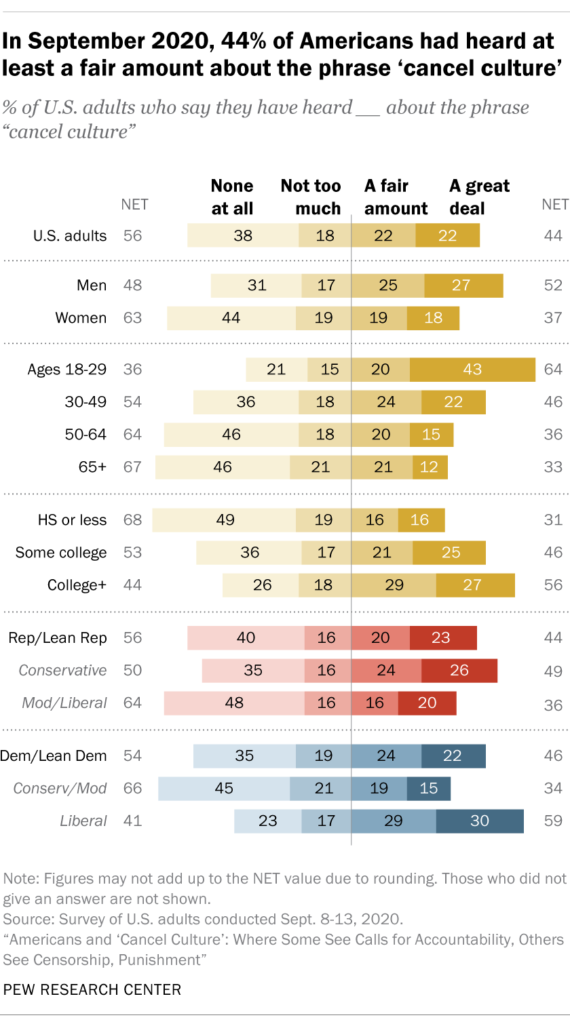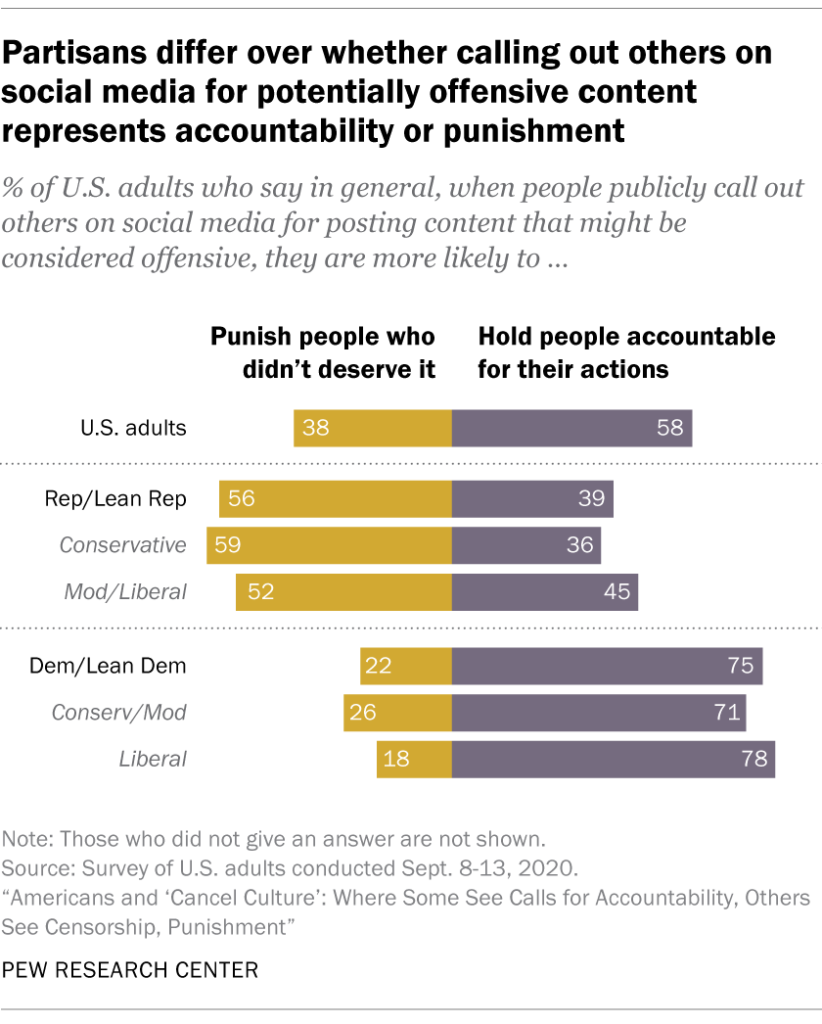30-second summary:
- Social media platforms allow anyone to publicly call out people and brands when they did or said something offensive or abusive
- Cancel culture is public outrage targeting an individual micro-celebrity or a brand for their public statements or actions
- To keep your brand safe from being canceled, create a detailed communication policy, avoid controversies and invest in sub-brands
- If you were affected by cancel culture, consider admitting your mistake and hire a crisis manager if the situation starts getting out of control
In 2021, major celebrities and brands like J.K Rowling, Ellen DeGeneres, Netflix, L’Oréal, and McAfee faced the wrath of netizens due to their actions, either intentional or unintentional – this was cancel culture in full throttle. People want to hold brands and celebrities accountable (at least for most of it) and marketers need to acknowledge that it is here to stay.
According to PEW research, 58 percent of U.S. adults say in general, calling out others on social media is more likely to hold people accountable. While there are various shades to cancel culture, I dive into understanding the crux of this phenomenon and what brands need to do to safeguard their reputation and identity online.
Source: PEW Research Center
What is “cancel culture”?
Cancel culture is the contemporary movement of expressing public disapproval of someone’s public statement or action.
When canceling refers to a brand, people are basically encouraging the public to stop buying from them. Canceling means boycotting a brand.
Obviously, social media provides a perfect platform for the cancel culture, giving anyone a voice and the means to unite people around one common outrage.
The idea of cancel culture is controversial.
On one hand, it raises a lot of legal questions. Public shaming goes back to the concept of public square trials when an individual could have been punished without their guilt being proved.
On the other hand, cancel culture is considered to be an important tool in achieving social justice.
How to keep your brand safe?
1. Develop thorough communication policies
Anyone who can publicly speak or publish content on your behalf should follow strict rules as to what they can or cannot say, which topics to avoid, who to alert of public feedback, etc.
This document is referred to as a communication policy.
It is helpful if the company’s executives are following that document as well because in many cases CEOs cause all the trouble.
For example, American University has a very detailed marketing and communication policy listing all kinds of rules their employees need to follow when sending email newsletters, posting on social media channels, and using third-party content, like pictures and videos.
Here are their communication guidelines for posting on social media – this will give you a sample of what your brand’s communication policy can look like.
-
Think twice before posting: Privacy does not exist in the world of social media. Consider what could happen if a post becomes widely known and how it may reflect on both the poster and the University… If you are unsure about posting something or responding to a comment, ask your supervisor for input.
- Strive for accuracy: Get the facts straight before posting them on social media.
- Be respectful: Understand that content contributed to a social media site could encourage comments or discussion of opposing ideas.
- On personal sites: Identify your views as your own.
-
Photography and comments: Do not post any comment or picture involving an AU employee, volunteer or student without their express consent.
A communication policy is not something you can build in a day. It should tackle different scenarios, provide policies for different channels and explain clear steps on:
- How to react to negative or positive comments and reviews.
- How to implement marketing tactics like emotional marketing and create case studies because these should be handled with extra care to protect your customers’ feelings and your clients’ privacy.
- How to ensure smooth communication with email automation (to avoid being called out for spam)
Set up your policy as an internal and searchable knowledge base to be able to expand it as you discover new and new situations and processes.
2. Avoid controversy (if you can)
As a founder and member of society, you may be tempted to use your public image and following to support what you feel is right and fair.
It may come at a high cost, so think twice before you do so.
Your public words may end up working against your brand and cause a crisis your team may be unprepared to handle.
When in doubt, keep silent.
Yet, it is getting increasingly harder to remain neutral
In today’s polarized world customers often demand their brands take one side and publicly define their stance. We’ve seen this happen in front of our eyes when Coca-Cola and McDonald’s were both forced to leave the Russian market after what seemed like a silent hesitation.
In many cases, silence is not an option. These days, remaining neutral means being complicit, and not many brands can afford that.
When confronted with the need to react to a political climate, consider taking an action over releasing a statement. A report claims that customers tend to be more forgiving to brands that took action instead of trying to please their audience with empty talk.
In other words, instead of condemning any side, start a fundraiser or donate money to the cause you’re supporting. At this point, whatever you say may backfire on you but at least action will be respected.
3. Admit and own up to your mistakes
While cancel culture may seem really scary, we see lots of examples of brands recovering from any crisis by simply apologizing.
If your company is facing public outrage
Arrange a meeting with your employees and discuss whether you may have been mischarged in your previous statement and what is the best way to address the accusations.
If you don’t feel you did anything wrong, your PR, communications, and legal teams may have a different opinion, so listen to them.
If your case seems bad enough and the accusations are mounting rapidly, consider hiring a crisis manager. In some cases, you need an outside perspective.
4. Invest in a sub-brand
For years we’ve been giving the same advice over and over again: Don’t create multiple brands. Focus on one.
Well, the recent years of an immediate cancellation threat over a possible clumsy public reaction have clearly demonstrated one thing: Your (personal) brand may be ruined within a day.
Of course, most brand names may be restored with enough reputation management efforts but it can take months for the public to forgive mistakes and become loyal again.
In this climate, having another brand name to lean on in case of a possible reputation crisis seems like a good idea.
We’ve seen lots of examples of a new brand name saving a business
To name a few, we’ve seen Rowling take on another pen name to continue writing, and McAfee changing its name to Intel Security to distance the company from its founder. There are numerous other case studies proving one definitive point: You may have invested your life into building a strong brand but it remains vulnerable, especially now that your brand’s cancellation may go viral.
Even if you are a small business or an independent entrepreneur, consider setting up an anonymous digital entity earlier to start building up your organic visibility. If anything happens to your main brand, you will have a backup to switch your focus on.
Worst-case scenario, your sub-brand will be never used but you will be able to use the site rankings to drive additional sales and leads.
5. Prioritize data privacy and security is a must
Privacy and security remain the biggest threat to any brand’s welfare. Even giants like Google Plus were forced to shut down after their data leak became public.
Cyberattacks may cause your customers to lose money and identity, which is very hard to overcome. It is especially dangerous in B2B marketing because it often involves working with a lot of sensitive data.
Create a healthy culture of security within your business for all your employees to be aware of data security protocols and protect customers’ private data.
- Ensure a culture of transparency to keep your employees informed on the latest risks and growing security threats as well as to list steps on what to do after a data breach.
- Make sure your customers are aware of your efforts to keep their data safe and your business compliant with privacy regulations.
Conclusion
We live in interesting times when everyone has a voice and we are still learning how to live in a world where any argument can go public and become viral. It is both scary and exciting to navigate these unknown waters but the good old “hope for the best, get ready for the worst” is almost always a good strategy. Good luck!
Ann Smarty is the Founder of Viral Content Bee, Brand and Community manager at Internet Marketing Ninjas. She can be found on Twitter @seosmarty.
Subscribe to the Search Engine Watch newsletter for insights on SEO, the search landscape, search marketing, digital marketing, leadership, podcasts, and more.
Join the conversation with us on LinkedIn and Twitter.
The post Cancel culture and what brands should be doing appeared first on Search Engine Watch.
This marketing news is not the copyright of Scott.Services – please click here to see the original source of this article. Author: Ann Smarty
For more SEO, PPC, internet marketing news please check out https://news.scott.services
Why not check out our SEO, PPC marketing services at https://www.scott.services
We’re also on:
https://www.facebook.com/scottdotservices/
https://twitter.com/scottdsmith
https://plus.google.com/112865305341039147737
The post Cancel culture and what brands should be doing appeared first on Scott.Services Online Marketing News.
source https://news.scott.services/cancel-culture-and-what-brands-should-be-doing/



No comments:
Post a Comment